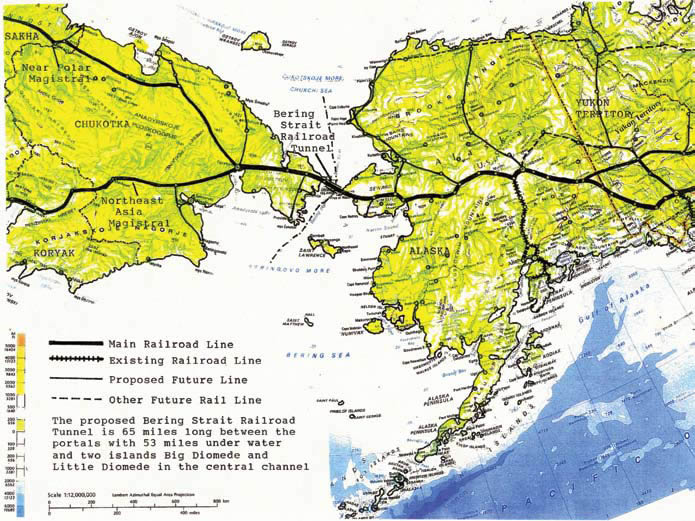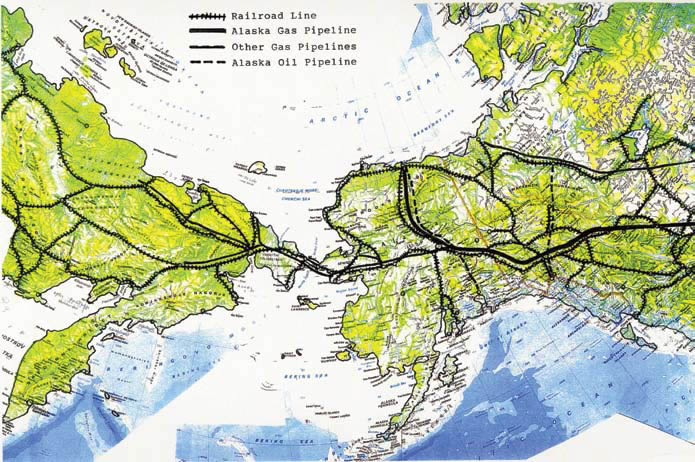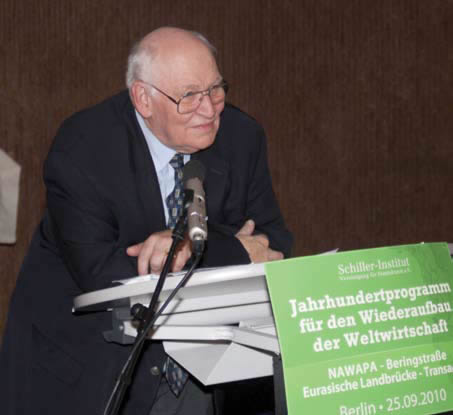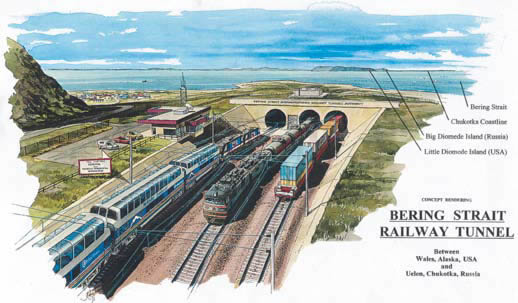German Schiller Institute Conference Presentation
A World Rail Network To End The British Imperial System
by Dr. Hal Cooper
September 2010
This article appears in the October 15, 2010 issue of Executive Intelligence Review and is reprinted with permission
|
Dr. Hal Cooper, the world-class engineer and infrastructure expert, addresses the Schiller Institute conference on “Rebuilding the World Economy.” He has long been a passionate advocate for constructing a rail/tunnel link across the Bering Strait, between Russia and Alaska. |
Dr. Hal Cooper, an engineer and infrastructure specialist, addressed a conference of the international Schiller Institute, on, “Rebuilding the World Economy—NAWAPA, the Bering Strait, and the Eurasian Land-Bridge,” on Sept. 25, in Berlin, Germany. Cooper laid out a project, on which he has worked for many years, to build a railroad/tunnel across the Bering Strait, connecting the United States and Russia.
It’s a pleasure to be back in Germany. . . .
I’m going to talk today about the Bering Strait tunnel project, which really, in a way, is an extension of the North American Water and Power Alliance, which I’ll have a little to say about at the end.
I just finished putting together a proposal on the Bering Strait tunnel, which was presented to Mr. Vladimir Yakunin, the president of the Russian Railways, in January of this year, in Frankfurt, at a meeting. And I’ll be happy to make copies available to anyone who would like a copy.
What is being proposed is a multi-mode energy and transportation system, between Russia and Alaska, at the critical juncture point between the Eastern and the Western Hemispheres of the world [Figure 1]. And the ultimate objective of that, is not only to promote transportation and energy transfer, but to bring about a political and economic realignment of the world. And ultimately that gets back to what Helga [Zepp-LaRouche] spoke about earlier, about the so-called Four-Power Alliance, Four-Power Agreement, this being Russia, China, India, and the United States—which is ultimately the objective—and a necessity for the Bering Strait tunnel to be built. It is not just about transportation logistics [Figure 2].
|
FIGURE 1 Proposed Route of the Interhemispheric Railroad To Connect Alaska and Chukotka Through the Bering Strait Railroad Tunnel |
|
FIGURE 2 Proposed Locations of the Bering Strait Railroad Tunnel and Natural Gas Pipeline Network |
Now, what is proposed would be an electric railroad—not diesel, but electric—in combination with a natural-gas pipeline, electric transmission, and fiber-optic telecommunications. At this point, we don’t see water transfers taking place through a tunnel, but we do see water transfers taking place on the approaching railroads in both North America and Asia.
You saw earlier today, during Helga’s presentation, the North American Water and Power Alliance, which would be bringing water from the Yukon and Mackenzie river basins of northwestern Canada, and Alaska, and the coastal-range-mountain short rivers, through trenches, aqueducts, and pipelines, to the lower 48 states of the United States, and ultimately to Mexico. Helga did not mention this, but another program that has been proposed by a LaRouche associate in Mexico, Manuel Frias, talks about water transfer projects from the southern part of Mexico, to the northern part, from the water-abundant regions of the Yucatan Peninsula, to the north, to the water-scarce regions. And this would be going from south to north, at the same time that the North American Water and Power Alliance would be bringing water from north to south, making all of this entire region productive for agriculture, industry, population development, and reversing this endless pattern of decline that we have seen for so many years, since 1971.
Now, what was proposed earlier goes back—believe it or not, the first time someone proposed building a tunnel under the Bering Strait, was by the governor of the Territory of Colorado, before it became a state, William Gilpin. He proposed building railroads from the 48 states—well, there weren’t 48 states then, there were still a lot of territories—from the United States, up through Canada, to Alaska, and then coming from Asia.
There were several other proposals made between then, and the turn of the century—some serious, and some not so serious, the most serious of which was in 1906, by a jointly owned company of Russian, French, and American investors, who actually raised $6 million. They did feasibility studies, and they began to raise $50 million to get started with construction.
Britain and the Politics of Oil
When one reads the book by William Engdahl about oil [A Century of War: Anglo-American Oil Politics and the New World Order], it is Mr. Engdahl’s hypothesis that this is the reason the British oligarchy started World War I, because they did not want land connections extending the railroad developments in the United States and Canada, between East and West, and in Russia, along the Trans-Siberian [Railway], between West and East, to connect. I personally agree with that. That’s exactly why World War I was started.
And of course, the opposition of the British oligarchy to developing the Bering Strait has never changed.
Now, we see a connection between Alaska and Chukotka, which is the region of Russia right across the Bering Strait from Alaska, from a place called Egvekinot [Russia], population 4,000, a gold-mining and fishing center, to Fairbanks, Alaska, a city of 80,000 people, some industry, some military, a supply center for the central part of Alaska, with a 950-mile corridor, approximately 1,600 kilometers between the center of Alaska, and the center of Chukotka, from which rail lines will connect to the southeast, to the main part of the United States. It will come to a place called Prince George, British Columbia, and to Dawson Creek, British Columbia, where major connections with the existing North American rail system can take place.
And on the Russian side, a connection to Yakutsk, to the south, and to the Trans-Siberian and Baikal-Amur Mainline. . . . And also, connections to the west of Russia. During Stalin’s time, in the 1930s, studies were actually undertaken, routes laid out, of a near-polar mainline along the south shore of the Arctic Ocean in Russia, and also a line going to the southwest, to connect to the Trans-Siberian Railway. And Russia has always taken a greater interest in the connection through the Bering Strait than has the United States. And what we’ve seen ever since Harry Truman, is opposition.
Believe it or not, in 1941, at the beginning of World War II, when Pearl Harbor was attacked, Stalin asked Roosevelt to send Harry Hopkins to Moscow, right after the attack, in late December of 1941. How could the United States supply Russia? Ships? Airplanes? And even the possibility of trains, and there was only one connection point, the Bering Strait.
At the time, it was felt that it was too difficult a logistical connection—it would take too long to build, it would be too much money, and so forth. But studies had already been done under Stalin. Actually, one of the reasons those studies were done, was actually to connect the concentration camp zones, where there was gold-mining, and other things going on. I understand today there is a renewed interest in mining activities of gold and other minerals in that region of Russia, and that is a very important thing, but not the major reason why we would develop these rail systems. It’s really for economic development, and political integration.
Now, when we build a tunnel, we build it through a combination of granite and limestone—it is relatively easy to dig, it’s just that the rock is generally hard, and it’s going to take some time, but we would put it about 100 feet below the water level, and the water would be about 60 to 70 meters deep, 180-200 feet. There are two islands in the middle: Little Diomede on the United States side, and Big Diomede on the Russian side. There are 200 people, Native people, who live on Little Diomede. Big Diomede is a weather station, and military base, with Russia.
Double-track railroad. Center utility tunnel, just like we have at the English Channel. And there is another tunnel, actually being built right now, connecting Europe and Asia, at the Bosporus, between the European and Asian sides of Istanbul, Turkey, called the Marmaray railway tunnel. It’s about 12 kilometers long, 8 miles, approximately. It’s a trench where precast concrete sections are placed at the bottom of the trench, and then at the ends there will be tunnel bores to take it to near the surface. Commuter trains and high-speed intercity passenger trains would run during the day; freight trains at night.
That is the western end of the Eurasian Land-Bridge. And the Bering Strait would be, really, the eastern end.
Electric Power and Water-Transfer
Now, I would forecast, and have proposed, a gas pipeline from Russia to Alaska, in a separate tube; an electric transmission line, probably using superconducting cables, because we can transmit very large amounts of electricity with minimal losses. And we would also be able to transfer electricity back and forth between Asia and North America; as the time of the day changes, and the peaks change, we can help equalize the loads, and, of course, it would also provide a means to facilitate the development of northern Alaska, and northeastern Russia: a critical component.
Now, on the water-transfer side, it isn’t directly a part of the Bering Strait tunnel, but of the approaching rail lines, it is. On the Alaska-Canada rail side, the North American Water and Power Alliance. That’s already been talked about today, and we will be hearing a lot more about it in the future. On the Asian side, it’s possible, as Helga mentioned, to take water from the Irtysh and some of the other rivers in Siberia, all of which flow north into the Arctic, and pump them to the South to refill the Aral Sea. Actually, we could put it in other places as well. And that would certainly help agriculture in that region.
Unfortunately, the Aral Sea has always been shown as an example of what’s wrong with water transfer. The problem is, it was never done right. And they didn’t transfer water to where it was really needed to be.
And of course, the McKenzie River in Canada, the Yukon River in Alaska and Canada, and then, on the Russian side, the Ob, the Irtysh, the Lena, the Yenesei, and the Kolyma, all flow north into the Arctic Ocean, and can provide substantial water. So that’s another issue.
Possibly we could put in a fiber-optic telecommunications cable—that’s a relatively minimal cost issue. So, we would have a utility/pipeline/railroad corridor. I would also propose building power plants, to supply the electricity—I estimate it would take about 2,000 megawatts, of which half would be for the railroad, and half for the local economic development of that region.
There’s a lot of mining on both sides. There’s gold mining in Chukotka. There’s other mining, especially to the west of the Sakha Republic. There’s gold mining and other mining in Alaska. There’s the lead and zinc mine at Red Dog. There are very large coal reserves in the Point Lay region of northwestern Alaska. Some of that could go to China, and I propose hauling it by rail, some of it. It’s very low-sulphur, very high-grade coal, and it could be used for some of the small industrial boilers in China, as well as home heating and cooking.
There are some people, but not all, who forecast that coal production in China may be falling, but demand continues to rise. It’s on its way down. China just signed an agreement with Australia to purchase 300 million tons of coal, for 20 years, being shipped out of Newcastle to China, and maybe there will be more in the future. I suspect there probably will. But it’s just one more reason to build the tunnel.
Now, the tunnel would be 100 kilometers long. The railroad itself would be 1,500 kilometers long, between Egvekinot, Chukotka and Fairbanks, Alaska. But we’re actually looking at connecting the main rail systems—together, we’re actually looking at about 8,000 kilometers, about 5,000 miles, with major connections on each side. The end point cities on each side of the Bering Strait: You will end in Uelen, which is a fishing village of about 300 people, and Wales, Alaska, which is a similar place, with about 200 people.
In terms of the cost, my estimate is that the tunnel itself is going to cost about $25 billion, and the entire rail system, connecting Fairbanks and Egvekinot, is about $45 billion. It would cost approximately $10 billion for the natural-gas pipeline, in that section, and approximately $10 billion for the high-voltage superconducting cable electricity in that section, as well.
And my estimate of the traffic: It would be increasing in the first year from 25 million tons a year, to about 270 million tons a year, by 2050, the starting point being between 2020 and 2022. And passenger service would provide approximately 5% of the revenue, 10% of the number of trains. To have passengers would be nice, but that is certainly not the main reason.
Interestingly enough, I did some studies on container movements between China and the United States, specifically between Xian, in Central China, and Chicago. It would take 8 to 10 days to ship that container by rail, 1 day by plane, 20 to 24 days by the existing ship-rail system, and 30 days if you went through the new Panama Canal, when it’s completed, and then shipped the container by rail at the end. So, there is a definite time-savings as well. And potentially, a cost saving. My estimate is that with the exception of all-water shipping, the rail would be competitive, and probably 5-10% less than shipping through the conventional ship-rail system, to the United States.
A Million New Jobs
Now, what would it do in terms of employment?
My estimate is that the construction itself would create between 25,000 and 50,000 jobs directly, and the operation would take between 10,000 and 15,000 people, when all the aspects, related maintenance, and operations, plus ancillary activities, are considered. And the indirect jobs would be those, the multiplier of 2.5 to 3, or whatever it comes out to—somewhere between 90,000 and 160,000 jobs. So, you’re really looking at between 700,000 and 1.2 million new jobs, when all economic activities are considered.
But what’s also going to happen is, Alaska and Chukotka are going to become the centers of trade for the world. When you go there now, you would say, that’s a pretty far fetch. But, when you have companies like UPS and Federal Express, and others, which would make use of that kind of service, with the trains running at 70 to 90 miles an hour, which can be relatively easily done, and of course, some people have suggested magnetic levitation. Personally, I think that’s something that’s a separate system—we’d have to add another tube for it.
Gauges: The standard of Europe, Western Europe, and the United States and China, and many other countries of the world, with standard gauges, 4 feet 8½ inches, 1,435 millimeters. The Russian gauge is 1,520 millimeters or 5.0 feet; it’s just different enough that you can’t run a train from one gauge onto the other.
The Koreans, the Polish, and the Spanish have come up with different systems—either cars or locomotives—that can be changed from one trackage to the other.
Now, China has announced that it’s going to build a new rail line, from Urumqi in western China, in conjunction with the countries along the route, Kazakstan, Uzbekistan, Turkmenistan, Iran, and Turkey—a standard gauge line, all the way through Central Asia, connected to Iran at Mashad, and then all the way to Tehran, and all the way to Istanbul. They also proposed building a line from Kunming in southwestern China, through Myanmar, and India, Pakistan, Iran, to connect at Tehran, to this system.
Just last month, there was a train that went from Istanbul, carrying containers all the way to Islamabad in Pakistan, and back. And there’s a new commercial service that just started—that, of course, is the Eurasian Land-Bridge. But it would connect, ultimately, to the lines going to the Bering Strait.
You will become an expert in geography studying where all these routes are. Going from a place called Ust-Kut, on the Baikal-Amur Mainline, to the northeast to Lensk, in the southwest of the Sakha Republic (Yakutia), and then across the new bridge between Haptagay and Tabaga, which is probably the most formidable single infrastructure project in this whole area, except for the tunnel itself. And when I spoke with Mr. Yakunin, he said, well, we’re going to have to get that problem resolved first, and the problem is primarily an economic one, in that it costs almost as much to build a 5 kilometer bridge as it does a 500 kilometer railroad, because of the complexities involved: that you’re going to need natural-gas pipelines, and oil pipelines, and water pipelines and roads and rails, and electric utilities, because everything has to go across the same bridge.
|
FIGURE 3 Bering Strait Railway Tunnel
|
I have in my paper a painting, which was done by the ever-popular Craig Thorpe, the noted railroad artist—some of you have seen his work, including on the Bering Strait tunnel, as it was presented in Kiedrich, in the 2007 event [Figure 3].
So, it is very important that all these things fit together as a system. And I can tell you, from having read the recent Russian Railways annual report—and I think our next speaker is going to discuss this in more detail—that there really are some advanced network plans going. And in fact, the Russian Railway has a very orderly 20-year plan, to build out to the Bering Strait, from the present end of its railroad, lacking a major international initiative to put all this together.
What Are the Benefits?
Now, why do we want to build it? What are the benefits?
Well, we certainly know about the jobs. We would create many jobs and new businesses. We would reduce transit times, and probably costs. We would create a land-based corridor without any maritime connection, so there isn’t going to be any more finagling of breaking up everybody into little groups, so they can all be controlled and manipulated against each other. That’s very important. I think coal shipments to China, oil shipments to the United States—some of it could go by rail—are important.
But I think that the Four-Power Agreement of Russia, China, India, and the United States, as Helga mentioned, is really one of the ultimate objectives.
But there is an even more important objective. And that is, creating a world rail system from Cape Horn, at the bottom of South America, to Cape Good Hope, at the bottom of Africa, and everything in-between, to create growth and prosperity, and end the reign of the British oligarchy.
And with that, I thank you.
Related pages:


